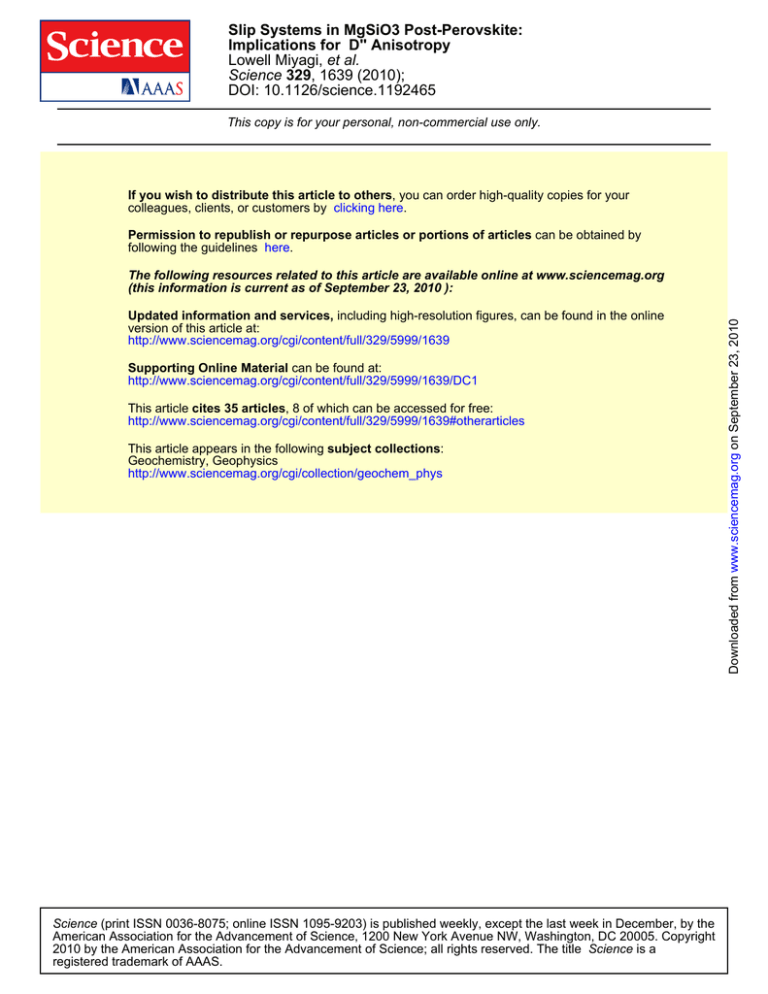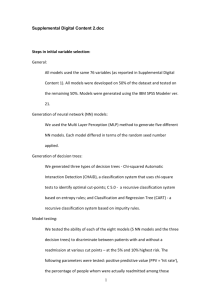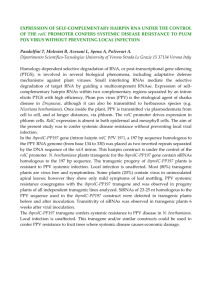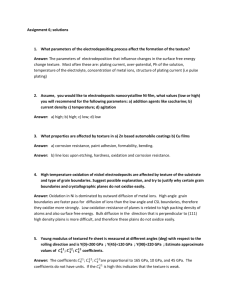Lowell Miyagi, , 1639 (2010); DOI: 10.1126/science.1192465
advertisement

Slip Systems in MgSiO3 Post-Perovskite:
Implications for D'' Anisotropy
Lowell Miyagi, et al.
Science 329, 1639 (2010);
DOI: 10.1126/science.1192465
This copy is for your personal, non-commercial use only.
If you wish to distribute this article to others, you can order high-quality copies for your
colleagues, clients, or customers by clicking here.
Permission to republish or repurpose articles or portions of articles can be obtained by
following the guidelines here.
Updated information and services, including high-resolution figures, can be found in the online
version of this article at:
http://www.sciencemag.org/cgi/content/full/329/5999/1639
Supporting Online Material can be found at:
http://www.sciencemag.org/cgi/content/full/329/5999/1639/DC1
This article cites 35 articles, 8 of which can be accessed for free:
http://www.sciencemag.org/cgi/content/full/329/5999/1639#otherarticles
This article appears in the following subject collections:
Geochemistry, Geophysics
http://www.sciencemag.org/cgi/collection/geochem_phys
Science (print ISSN 0036-8075; online ISSN 1095-9203) is published weekly, except the last week in December, by the
American Association for the Advancement of Science, 1200 New York Avenue NW, Washington, DC 20005. Copyright
2010 by the American Association for the Advancement of Science; all rights reserved. The title Science is a
registered trademark of AAAS.
Downloaded from www.sciencemag.org on September 23, 2010
The following resources related to this article are available online at www.sciencemag.org
(this information is current as of September 23, 2010 ):
REPORTS
Capacitance (µF)
400
300
200
100
0
10-2
10-1
100
101
102
103
104
105
Frequency (Hz)
Fig. 4. Capacitance versus frequency of the
graphene nanosheet DLC, assuming a series-RC circuit
model. Capacitive behavior is shown up to ~104 Hz.
inary part of the impedance. Capacitance versus
frequency from this equation is plotted in Fig. 4
for the graphene nanosheet capacitor shown in
the previous figures. At 120 Hz, the derived capacitance value is 175 mF, and the measured
resistance is 1.1 ohms, yielding an RC time
constant of less than 200 ms. Divergent behavior
near 20 kHz is an artifact of the model (where Z″
passes through zero) and should be ignored. As
shown, the capacitance value increases from
~175 mF in the 10- to 104-Hz band up to ~375
mF at frequencies below ~1 Hz. The increase occurs in the region of the phase angle dip shown in
Fig. 3. Capacitance saturation (horizontal behavior)
was not observed even at 0.01 Hz, although this
device exhibited incredibly fast response, suggesting the involvement of a second, much-lower-rate
charge-storage process. Three-electrode measurements revealed that the positive electrode had
greater capacitance increase at low frequency
than did the negative electrode. Capacitors of the
same design fabricated by using bare Ni electrodes
had capacitance values of less than 25 mF at 120 Hz.
We attribute the marked capacitance increase at
low frequency to pseudocapacitance derived from
ion intercalation into the exposed edge planes of
the graphene structure. Pseudocapacitance by
this mechanism has been reported for exfoliated
carbon fibers with sulfuric acid electrolyte (20).
A similar vertically oriented graphene nanosheet capacitor fabricated with an organic electrolyte (1 M tetraethylammonium-tetrafluoroborate
salt in propylene carbonate) showed more definite but still incomplete saturation of capacitance
at low frequency (fig. S1). The organic electrolyte capacitance was ~50% higher than the value
from aqueous electrolyte prototypes, which is opposite to typical activated carbon behavior. This
boost in capacitance using the organic electrolyte
may result from more complete wetting of the
graphene nanosheet surface with this electrolyte.
Capacitance at 120 Hz was ~175 mF for the
graphene nanosheet capacitor (with KOH elec-
trolyte), which corresponds to a capacitance density of the 0.6-mm-thick active layer of ~3 F/cm3.
The graphene active layer stored ~1.5 FV/cm3 with
the aqueous electrolyte (0.5 V) and ~5.5 FV/cm3
with the organic electrolyte (1.25 V). Aluminum
electrolytic capacitor foil is highly etched before
being anodized so as to create charge storage
throughout its volume. Low-voltage aluminum
anode foil (KDK, Tokyo, Japan) has CV/volume
values up to ~0.14 FV/cm3. Thus, a graphene DLC
in principal could have substantially smaller volume than a comparably rated low-voltage aluminum electrolytic capacitor.
DLC designs would differ from the spiralwound construction commonly used with aluminum electrolytic capacitors because of operating
voltage differences. A bipolar design (cell stacking), as presently used by several DLC manufacturers, offers volumetric efficiency and may
be optimal. With stacked cells, DLC capacitance
density scales like the inverse of the square of the
number of series-connected cells: ~1/V2, where
V is the device operating voltage. Capacitance
density of an electrolytic capacitor scales like 1/V
because the CV product of anodic dielectric is
approximately constant. Thus, DLC capacitance
density advantages will disappear at a particular
voltage. Using prototype performance measurements with conventional construction materials
in a practical design (fig. S2), a single-cell graphene
DLC (~2.5 V operation) should offer a sixfold or
greater volume advantage over an aluminum electrolytic capacitor of the same rating. A two-cell
graphene DLC (~5 V operation) should offer a
twofold or greater volume advantage over an equivalently rated aluminum electrolytic capacitor. No
volumetric advantages are expected at higher
voltage. Aluminum electrolytic capacitors rated
at 2 Vor higher are widely used today for bypass
and filtering in portable electronics equipment.
Graphene nanosheet electrodes could be manufactured by using standard semiconductor process
equipment. The fabrication of the electrode and the
choice of electrolyte have not been optimized, and
increases in capacitance density through further optimization appear likely. Cell operating voltage
may be increased with ionic liquid electrolytes or
by use of an asymmetric design, with either approach
expanding the voltage region in which the graphene
DLC capacitance density exceeds that of present
aluminum electrolytic capacitor technology.
References and Notes
1. B. E. Conway, Electrochemical Supercapacitors:
Scientific Fundamentals and Technological Applications
(Kluwer Academic/Plenum, New York, 1999).
2. J. R. Miller, A. F. Burke, Electrochem. Soc. Interface 17,
53 (2008).
3. J. R. Miller, Batt. Ener. Stor. Technol. 18, 61 (2007).
4. A. F. Burke, J. E. Hardin, E. J. Dowgiallo, “Applications
of Ultracapacitors in Electric Vehicle Propulsion Systems,”
presented at the 34th Power Sources Conference,
Cherry Hill, NJ (1990).
5. J. R. Miller, P. Simon, Science 321, 651 (2008).
6. D. L. Boos, S. D. Argade, “Historical Background and New
Perspectives for Double-Layer Capacitors,” presented at the
1st International Seminar on Double Layer Capacitors and
Similar Energy Storage Devices, Deerfield Beach, FL (1991).
7. R. de Levie, P. Delahay, C. W. Tobias, Eds., Advances in
Electrochemistry and Electrochemical Engineering
(Interscience, New York, 1967).
8. C. Niu, E. K. Sichel, R. Hoch, D. Moy, H. Tennent,
Appl. Phys. Lett. 70, 1480 (1997).
9. C. Du, N. Pan, J. Power Sources 160, 1487 (2006).
10. C. Du, N. Pan, Nanotechnology 17, 5314 (2006).
11. C. Du, N. Pan, Nanotechnol. Law Bus. 4, 569 (2007).
12. J. Schindall, J. Kassakian, R. Signorelli, paper presented at the
2007 Advanced Capacitor World Summit, San Diego, CA (2007).
13. Y. Honda et al., Electrochem. Solid-State Lett. 10, A106 (2007).
14. M. D. Stoller, S. Park, Y. Zhu, J. An, R. S. Ruoff,
Nano Lett. 8, 3498 (2008).
15. X. Zhao et al., J. Power Sources 194, 1208 (2009).
16. J. P. Randin, E. Yeager, J. Electrochem. Soc. 118, 711 (1971).
17. J. Wang et al., Appl. Phys. Lett. 85, 1265 (2004).
18. M. Zhu et al., Carbon 45, 2229 (2007).
19. I. D. Raistrick, in Electrochemistry of Semiconductors and
Electronics, J. McHardy, F. Ludwig, Eds. (Noyes
Publications, Park Ridge, NJ, 1992), pp. 297–355.
20. Y. Sonedaa et al., J. Phys. Chem. Solids 65, 219 (2004).
21. This work was supported in part by DARPA Defense
Sciences Office, 3701 N. Fairfax Dr., Arlington, VA 22203.
Supporting Online Material
www.sciencemag.org/cgi/content/full/329/5999/1637/DC1
Figs. S1 and S2
28 June 2010; accepted 19 August 2010
10.1126/science.1194372
Downloaded from www.sciencemag.org on September 23, 2010
500
Slip Systems in MgSiO3 Post-Perovskite:
Implications for D′′ Anisotropy
Lowell Miyagi,1 Waruntorn Kanitpanyacharoen,2 Pamela Kaercher,2
Kanani K. M. Lee,1 Hans-Rudolf Wenk2*
Understanding deformation of mineral phases in the lowermost mantle is important for interpreting seismic
anisotropy in Earth’s interior. Recently, there has been considerable controversy regarding deformationinduced slip in MgSiO3 post-perovskite. Here, we observe that (001) lattice planes are oriented at high angles
to the compression direction immediately after transformation and before deformation. Upon compression
from 148 gigapascals (GPa) to 185 GPa, this preferred orientation more than doubles in strength, implying
slip on (001) lattice planes. This contrasts with a previous experiment that recorded preferred orientation
likely generated during the phase transformation rather than deformation. If we use our results to model
deformation and anisotropy development in the D′′ region of the lower mantle, shear-wave splitting
(characterized by fast horizontally polarized shear waves) is consistent with seismic observations.
T
he D′′ region lies just above the core mantle
boundary (CMB). In contrast to the bulk of
the lower mantle, this ~200-km-thick layer
www.sciencemag.org
SCIENCE
VOL 329
possesses apparent seismic complexity, including
seismic discontinuity, large topographic variations,
lateral heterogeneity, variable anisotropy, and ultra-
24 SEPTEMBER 2010
1639
low velocity zones (1–4). The D′′ region is of great
interest from a geodynamic perspective because it
is a boundary layer between two regions with
extreme viscosity contrasts (i.e., the solid mantle
and liquid outer core). As such, it should play an
active role in controlling mantle convection, thermal structure, and evolution of Earth (5). Numerical modeling (6) and laboratory experiments (7)
indicate that deformation is enhanced near boundary layers, and large strain deformation is expected
to occur in the D′′ region, particularly in slabs subducted to the CMB. Thus, it is likely that seismic
anisotropies observed in this region are produced
by deformation-induced texturing (preferred orientation) of the constituent minerals (2, 6, 7).
The discovery of a solid-solid phase transition in MgSiO3 from a perovskite (Pv) to a postperovskite (pPv) structure at conditions closely
corresponding to those of the CMB (127 GPa and
2500 K) provided a new perspective for interpreting the D′′ layer (8–10). However, several issues
remain unresolved, including how texture develops
in pPv and how the deformation state in the D′′
is expressed as seismic anisotropy. Texture may
be important in explaining the sharpness of the
D′′ discontinuity (11); seismological observations
suggest the thickness of the discontinuity to be
less than 30 km (12), but experimental data predicts that the thicknesses should be on the order
of 90 km for an isotropic aggregate (13–15).
When stress is applied to a polycrystal, individual crystals deform preferentially along slip
planes. This results in crystal rotations that in turn
lead to preferred orientation of the polycrystal
(texture). Because individual crystals are anisotropic, texturing can result in bulk anisotropy.
Previous deformation experiments on MgSiO3 pPv
and the MgGeO3 pPv analog produced textures
consistent with slip on {110} and/or (100) planes
(16, 17); however, these slip systems are expected
to generate anisotropy largely incompatible with
seismic observations. The older experiments showed
that texture developed during conversion to the pPv
phase and that further compression did not result
in textural changes (16, 17). Recently, Okada et al.
(18) performed new experiments on MgGeO3 pPv.
After transformation from the Pv to pPv phase, (001)
planes were oriented at high angles to compression.
When MgGeO3 enstatite was used as a starting material, axial diffraction patterns consistent with the
textures of Merkel et al. (16, 17) were observed.
After further compression, it appeared that (001)
planes became aligned normal to compression, implying that the former texture is related to the phase
transformation (18).
In the CaIrO3 pPv analog, however, the dominant slip plane is (010) over a range of pressures,
temperatures, and strain rates (19, 20–23). This
differing slip system may arise due to bonding
1
Department of Geology and Geophysics, Yale University, New
Haven, CT 06511, USA. 2Department of Earth and Planetary
Science, University of California, Berkeley, CA 94720, USA.
*To whom correspondence should be addressed. E-mail:
wenk@berkeley.edu
1640
differences in CaIrO3 pPv from other pPv structured
compounds (24). First-principles computations
also find CaIrO3 pPv to have elastic properties and
an electronic structure that are different from
MgSiO3 pPv (25), and modeling of dislocation
cores predicts that CaIrO3 is much more plastically anisotropic than MgSiO3 pPv (26, 27).
We performed axial compression experiments
on MgSiO3 pPv between 148 GPa and 185 GPa
in the diamond anvil cell (DAC). The evolution
of texture and lattice strains were recorded in situ,
using monochromatic synchrotron x-ray diffraction in radial geometry. The starting material of
vitreous MgSiO3 was mixed with ~10 weight percent Pt powder to serve as a laser absorber and a
pressure standard, and was compressed to high
pressure (28). Conversion directly to the pPv phase
was obtained by laser heating at ~3500 K for ~10
min (28). After conversion to pPv, pressure in the
sample was 148 GPa (table S2). Pressure was
then increased in four steps to 185 GPa over the
course of 7 hours (table S2). At each step, in situ
radial x-ray diffraction images were collected to
document the evolution of pressure, differential
stress, and texture.
Radial diffraction images show variations in
peak position with respect to the compression
direction, which indicate elastic stresses imposed
by the DAC, as well as systematic intensity variations, which denote texture. These variations are
best visualized if the image is unrolled to display
azimuth versus diffraction angle (Fig. 1). To quantitatively extract texture information and calculate
differential stress, we use the Rietveld method as
implemented in the software package MAUD
(28, 29). After conversion, at 148 GPa, differential stress was 5.3 T 0.1 GPa. At the highest
pressure attained, 185 GPa, the differential stress
was 10.9 T 0.5 GPa (table S2). Inverse pole figures (IPF) of the compression direction show the
probability of finding the pole (normal) to a lattice plane in the compression direction (Fig. 2).
Just after conversion to pPv, the sample exhibits a
texture characterized by (001) lattice planes at
high angles to compression, with an IPF maximum of 4.09 multiples of a random distribution
(m.r.d.) (Fig. 2A and table S2). After the first
compression step to 164 GPa, the strength of the
001 maximum increases dramatically to 9.62 m.r.d.
(Fig. 2B and table S2). Between 164 GPa and 185
GPa, texture changes very little (Fig. 2, B and C,
and table S2). This differs from textures recorded
in lower-pressure pPv analogs of Mn2O3 (30),
CaIrO3 (19, 20–23), MgGeO3 (16), and MgSiO3
(17) but is consistent with the most recent measurements on MgGeO3 pPv (18). These textures
are stronger than textures recorded in previous
experiments (16, 17). In this experiment, texture
strength after compression is greater than 9 m.r.d.
versus ~2.5 m.r.d. in MgSiO3 pPv (17), ~2.5 m.r.d.
in MgGeO3 pPv (30), and ~1.8 m.r.d. in CaIrO3
pPv (23). The present results cannot be directly
compared with the results of Okada et al. (18) because those measurements were qualitative.
In contrast to a previous DAC experiment on
MgSiO3 pPv (17), we observe a texture evolution with compression and conclude that the
strengthening of the 001 texture is due to plastic
Fig. 1. “Unrolled” diffraction image of MgSiO3
pPv taken in situ at 185
GPa (bottom) with the fit
from Rietveld refinement
(top). The region from
2.77 to 3.66 Å−1 was excludedfromRietveld refinement due to very intense
diffraction from the gasket and little signal from
the sample. pPv diffraction peaks are labeled, and black arrows indicate the compression direction. Straight lines are from the gasket.
The Pt 220 peak is also labeled and overlaps with the sample. Pt 111 and 200 are buried in the gasket peaks.
There may also be some minor formation of PtC due to the reaction of Pt with the diamonds during laser heating
(28). Texture is evident as systematic intensity variations along diffraction peaks. For example, pPv 004 has a
strong maximum in the compression direction. Deviatoric stress can be calculated from the variation of peak
position with azimuth, which is observed in the diffraction image.
Fig. 2. Inverse pole figures
of MgSiO3 pPv at 148 GPa
(A) just after transformation
and at two pressure steps up
to 185 GPa (C). Also shown
for comparison is an IPF of
VPSC results for dominant slip
on (001) and 40% compressive strain (D). This provides
a good match to the data after compression (B and C). Equal area projection and a linear scale is used. Scale
bar in m.r.d., where m.r.d. = 1 is random and a higher m.r.d. number indicates stronger texture.
24 SEPTEMBER 2010
VOL 329
SCIENCE
www.sciencemag.org
Downloaded from www.sciencemag.org on September 23, 2010
REPORTS
Fig. 3. Equal area projection pole figures showing texture development
and anisotropic elastic
properties of a pPv aggregate in a subducting slab
near the core-mantle
boundary using deformation mechanisms established in this study. (A)
(001) pole figure of pPv showing a snapshot during spreading in a plane strain regime (i.e., intermediate between pure shear and simple shear). (B) Fast shear-wave velocities and polarization. (C) Slow
shear-wave velocities. (D) P wave velocity surface. Flow direction indicated by arrow.
deformation. Deformation of pPv has been extensively modeled using the viscoplastic selfconsistent polycrystal plasticity code [VPSC; (31)]
(16, 17, 23). A comparison of the IPFs obtained
in this study with results of VPSC models shows
that the 001 texture observed here is compatible
with dominant slip on (001) lattice planes and
40% compressive strain (Fig. 2D). For this model, the transformation texture obtained after conversion to pPv was used as the starting texture for
the deformation simulation (Fig. 2A).
Admittedly, there are limitations to our experiments because the time scale of deformation,
grain size, composition, temperature, and deviatoric stress are quite different from those expected
in the D′′. However, if we assume that slip is active
on (001) planes in MgSiO3 pPv at D′′ conditions
and combine this information with geodynamic
modeling of deformation along the D′′, we can predict texture development in the lowermost mantle.
This can, in turn, be combined with single crystal
elastic constants to assess associated seismic anisotropy. For these calculations, we neglect any contribution from the second most abundant mineral in
the mantle, ferropericlase, which may also play
an important role in generating D′′ anisotropy (32).
In this context, we use information from the
same two-dimensional geodynamic model applied previously (17, 33) to predict texture development in a slab subducted into the D′′ zone.
A tracer records the strain-temperature history
and, accordingly, the texture evolution is modeled
with the same polycrystal plasticity theory applied to the experiment (31). It is assumed that
the aggregate has a random orientation distribution as it enters the D′′ about 290 km above the
CMB. Based on our results, we assume dominant
(001)[100] and (001)[010] slip. We chose a geodynamic tracer that records strain and temperature,
which advances close to the CMB and attains large
strains. Preferred orientation develops rapidly and
then stabilizes; note the strong alignment of (001)
lattice planes slightly inclined to the CMB (Fig.
3A). By averaging the orientation distribution and
single crystal elastic properties (34), we calculated
aggregate elastic properties and seismic wave propagation. Based on the polarization directions of the
fast and slow shear-wave velocities, high shearwave splitting is 0.55 km/s in the flow direction;
fast shear waves are polarized parallel to the CMB
(Fig. 3B, C). This is consistent with seismic
observations of the circum-Pacific regions (2, 4),
where the presence of pPv is expected (35, 36).
The anticorrelation between fast S waves and P
waves in the flow direction (Fig. 3D) is also
consistent with seismic records (37, 38).
References and Notes
1. D. Helmberger, T. Lay, S. Ni, M. Gurnis, Proc. Natl. Acad.
Sci. U.S.A. 102, 17257 (2005).
2. J. Wookey, J. Kendall, in Post-Perovskite: The Last Mantle
Phase Transition, K. Hirose, D. Yuen, T. Lay,
J. P. Brodholt, Eds. (American Geophysical Union,
Washington DC, 2007), pp. 171–189.
3. E. J. Garnero, A. K. McNamara, Science 320, 626 (2008).
4. M. Panning, B. Romanowicz, Science 303, 351 (2004).
5. P. J. Tackley, Science 288, 2002 (2000).
6. A. K. McNamara, P. E. V. Keken, S. Karato, J. Geophys. Res.
108, (B5), 2230 (2003).
7. N. Loubet, N. M. Ribe, Y. Gamblin, Geochem. Geophys.
Geosyst. 10, Q10004 (2009).
8. M. Murakami, K. Hirose, K. Kawamura, N. Sata, Y. Ohishi,
Science 304, 855 (2004).
9. A. R. Oganov, S. Ono, Nature 430, 445 (2004).
10. S. Shim, T. S. Duffy, R. Jeanloz, G. Shen, Geophys. Res. Lett.
31, L10603 (2004).
11. M. Murakami, K. Hirose, N. Sata, Y. Ohishi, Geophys. Res. Lett.
32, L03304 (2005).
12. T. Lay, Geophys. Res. Lett. 35, L03304 (2008).
13. K. Ohta, K. Hirose, N. Sata, Y. Ohishi, Geochim.
Cosmochim. Acta 70, A454 (2006).
14. K. Catalli, S. H. Shim, V. Prakapenka, Nature 462, 782 (2009).
15. D. Andrault et al., Earth Planet. Sci. Lett. 293, 90 (2010).
16. S. Merkel et al., Science 311, 644 (2006).
17. S. Merkel et al., Science 316, 1729 (2007).
18. T. Okada, T. Yagi, K. Niwa, T. Kikegawa, Phys. Earth
Planet. Inter. 180, 195 (2010).
19. N. P. Walte et al., Geophys. Res. Lett. 36, L04302 (2009).
20. N. Miyajima, K. Ohgushi, M. Ichihara, T. Yagi,
Geophys. Res. Lett. 33, L12302 (2006).
21. D. Yamazaki, T. Yoshino, H. Ohfuji, J. Ando, A. Yoneda,
Earth Planet. Sci. Lett. 252, 372 (2006).
22. K. Niwa et al., Phys. Chem. Miner. 34, 679 (2007).
23. L. Miyagi et al., Earth Planet. Sci. Lett. 268, 515 (2008).
24. J. Hustoft, S. Shim, A. Kubo, N. Nishiyama, Am. Mineral.
93, 1654 (2008).
25. T. Tsuchiya, J. Tsuchiya, Phys. Rev. B 76, 144119 (2007).
26. P. Carrez, D. Ferré, P. Cordier, Philos. Mag. 87, 3229 (2007).
27. A. Metsue, P. Carrez, D. Mainprice, P. Cordier, Phys. Earth
Planet. Inter. 174, 165 (2009).
28. Materials and methods are available as supporting
material on Science Online.
29. L. Lutterotti, S. Matthies, H. Wenk, A. S. Schultz,
J. W. Richardson, J. Appl. Phys. 81, 594 (1997).
30. J. Santillán, S. Shim, G. Shen, V. B. Prakapenka,
Geophys. Res. Lett. 33, L15307 (2006).
31. R. Lebensohn, C. Tomé, Mater. Sci. Eng. A 175, 71 (1994).
32. M. D. Long, X. Xiao, Z. Jiang, B. Evans, S. Karato,
Phys. Earth Planet. Inter. 156, 75 (2006).
33. A. K. McNamara, S. Zhong, Nature 437, 1136 (2005).
34. S. Stackhouse, J. P. Brodholt, J. Wookey, J. Kendall,
G. D. Price, Earth Planet. Sci. Lett. 230, 1 (2005).
35. J. W. Hernlund, C. Thomas, P. J. Tackley, Nature 434,
882 (2005).
36. R. D. van der Hilst et al., Science 315, 1813 (2007).
37. G. Masters, G. Laske, H. Bolton, A. M. Dziewonski, in
Earth’s Deep Interior: Mineral Physics and Tomography
From the Atomic to Global Scale, S.-I. Karato,
A. M. Forte, R. C. Liebermann, G. Masters, L. Stixrude,
Eds. (American Geophysical Union, Washington DC,
2000), pp. 63–87.
38. M. Ishii, J. Tromp, Phys. Earth Planet. Inter. 146, 113 (2004).
39. The Advanced Light Source is supported by the Director,
Office of Science, Office of Basic Energy Sciences, and
Materials Sciences Division of the U.S. Department of
Energy under contract DE-AC02-05CH11231. This
research was partially supported by the Consortium for
Materials Properties Research in Earth Sciences under
NSF Cooperative Agreement EAR 06-49658.
L.M. acknowledges support of the Bateman Fellowship at
Yale University. H.R.W. acknowledges support from
CDAC and NSF grants EAR0836402 and EAR0757608.
We thank S. Gaudio, C. Lesher, S. Clark, J. Knight,
and J. Yan for technical assistance. Comments from
three anonymous reviewers improved the manuscript.
Supporting Online Material
www.sciencemag.org/cgi/content/full/329/5999/1639/DC1
Materials and Methods
Figs. S1 and S2
Tables S1 and S2
References
18 May 2010; accepted 20 August 2010
10.1126/science.1192465
Downloaded from www.sciencemag.org on September 23, 2010
REPORTS
Genetic Restoration of the Florida Panther
Warren E. Johnson,1*† David P. Onorato,2*† Melody E. Roelke,3* E. Darrell Land,2*
Mark Cunningham,2 Robert C. Belden,4 Roy McBride,5 Deborah Jansen,6 Mark Lotz,2
David Shindle,2 JoGayle Howard,8 David E. Wildt,8 Linda M. Penfold,9 Jeffrey A. Hostetler,10
Madan K. Oli,10 Stephen J. O’Brien1†
The rediscovery of remnant Florida panthers (Puma concolor coryi) in southern Florida swamplands prompted a
program to protect and stabilize the population. In 1995, conservation managers translocated eight female
pumas (P. c. stanleyana) from Texas to increase depleted genetic diversity, improve population numbers,
and reverse indications of inbreeding depression. We have assessed the demographic, population-genetic,
and biomedical consequences of this restoration experiment and show that panther numbers increased
threefold, genetic heterozygosity doubled, survival and fitness measures improved, and inbreeding
correlates declined significantly. Although these results are encouraging, continued habitat loss, persistent
inbreeding, infectious agents, and possible habitat saturation pose new dilemmas. This intensive management
program illustrates the challenges of maintaining populations of large predators worldwide.
umas (also called cougars, mountain lions,
or panthers) are currently distributed throughout western North America and much of
P
www.sciencemag.org
SCIENCE
VOL 329
Central and South America (1). The endangered
Florida panther (listed in 1967, table S1), the last
surviving puma subspecies in eastern North Amer-
24 SEPTEMBER 2010
1641







